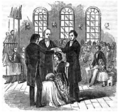Portal:Latter Day Saint movement
|
Welcome to the portal of The Latter Day Saint movement
Introduction The Latter Day Saint movement (also called the LDS movement, LDS restorationist movement, or Smith–Rigdon movement) is the collection of independent church groups that trace their origins to a Christian Restorationist movement founded by Joseph Smith in the late 1820s. Collectively, these churches have over 17 million nominal members, including over 17 million belonging to the Church of Jesus Christ of Latter-day Saints (LDS Church), 250,000 in Community of Christ, and several other denominations with memberships generally ranging in the thousands of members. The predominant theology of the churches in the movement is Mormonism, which sees itself as restoring again on Earth the early Christian church; their members are most commonly known as Mormons. An additional doctrine of the church allows for prophets to receive and publish modern-day revelations. A minority of Latter Day Saint adherents, such as members of Community of Christ, have been influenced by Protestant theologies while maintaining certain distinctive beliefs and practices including continuing revelation, an open canon of scripture and building temples. Other groups include the Remnant Church of Jesus Christ of Latter Day Saints, which supports lineal succession of leadership from Smith's descendants, and the more controversial Fundamentalist Church of Jesus Christ of Latter-Day Saints, which defends the practice of polygamy. (Full article...) General images -The following are images from various Latter Day Saint movement-related articles on Wikipedia.
Selected article Blood atonement was a practice in the history of Mormonism still adhered to by some fundamentalist splinter groups, under which the atonement of Jesus does not redeem an eternal sin. To atone for an eternal sin, the sinner should be killed in a way that allows his blood to be shed upon the ground as a sacrificial offering, so he does not become a son of perdition. The largest Mormon denomination, the Church of Jesus Christ of Latter-day Saints (LDS Church), has denied the validity of the doctrine since 1889 with early church leaders referring to it as a "fiction" and later church leaders referring to it as a "theoretical principle" that had never been implemented in the LDS Church. The doctrine arose among early Mormon leaders and it was significantly promoted during the Mormon Reformation, when Brigham Young governed the Utah Territory as a near-theocracy. According to Young and other members of his First Presidency, eternal sins that needed blood atonements included apostasy, theft and fornication (sodomy and adultery were two sins that did not need blood atonements). (Full article...)Selected location
Voree (/vɔːriː/) is an unincorporated community in the Town of Spring Prairie in Walworth County, Wisconsin, United States. It is best known as the headquarters of the Church of Jesus Christ of Latter Day Saints (Strangite), a denomination of the Latter Day Saint movement. According to James Strang, founder of the Strangite church and of the town, the name means "Garden of Peace". The community is situated along former Wisconsin Highway 11, just west of the Racine County line. (Full article...)
Selected schismatic histories
The Church of Jesus Christ (Cutlerite) is a denomination of the Latter Day Saint movement headquartered in Independence, Missouri, United States. The church derives its epithet from its founder, Alpheus Cutler, a member of the Nauvoo High Council and of Joseph Smith's Council of Fifty. Cutler justified his establishment of an independent church organization by asserting that God had "rejected" Smith's organization—but not his priesthood—following Smith's death, but that Smith had named Cutler to a singular "Quorum of Seven" in anticipation of this event, with a unique prerogative to reorganize the church that no one beyond this group possessed. Hence, Cutler's organization claims to be the only legitimate Latter Day Saint church in the world today. Currently, it has only one branch, located in Independence. The Cutlerite church retains an endowment ceremony believed to date to the Nauvoo period, practices the United Order of Enoch, and accepts baptism for the dead, but not eternal marriage or polygamy. (Full article...)
OutlinesRelated portalsKey biographiesThe life of Joseph Smith from 1827 to 1830, when he was 22–25 years old, begins in late 1827, after Smith announced he had obtained a book of golden Plates buried in a hill near his home in Manchester, New York (near Palmyra village). Because of opposition by former treasure-seeking colleagues who believed they owned a share of the golden plates, Smith prepared to leave the Palmyra area for his wife's home town of Harmony, Pennsylvania (now Oakland). From late 1827 to the end of 1830, Smith wrote and published the Book of Mormon, and established the Church of Christ. To write the Book of Mormon, Smith enlisted the assistance of Martin Harris, a wealthy Palmyra landowner who acted as Smith's scribe. Smith said that he used seer stones (one set of which Smith later called the Urim and Thummim) translate the plates he said to possess. Translation ceased, however, when Harris lost 116 manuscript pages of uncopied text. Translation resumed in earnest when Smith was joined in May 1829 by a Smith family associate named Oliver Cowdery. Translation was completed near the end of July 1829, and the resulting manuscript was published as the Book of Mormon on March 26, 1830, in Palmyra. (Full article...)Selected image In the Mormon fundamentalist movement, the 1886 Revelation is the text of a revelation said to have been received by John Taylor, third President of The Church of Jesus Christ of Latter-day Saints (LDS Church), that is claimed to restate the permanence of the principle of plural marriage.
Did you know (auto generated)
Selected Anniversaries
Selected quote
TopicsFeatured contentCategoriesWikiProjectsAssociated WikimediaThe following Wikimedia Foundation sister projects provide more on this subject:
Discover Wikipedia using portals | ||||||||







































